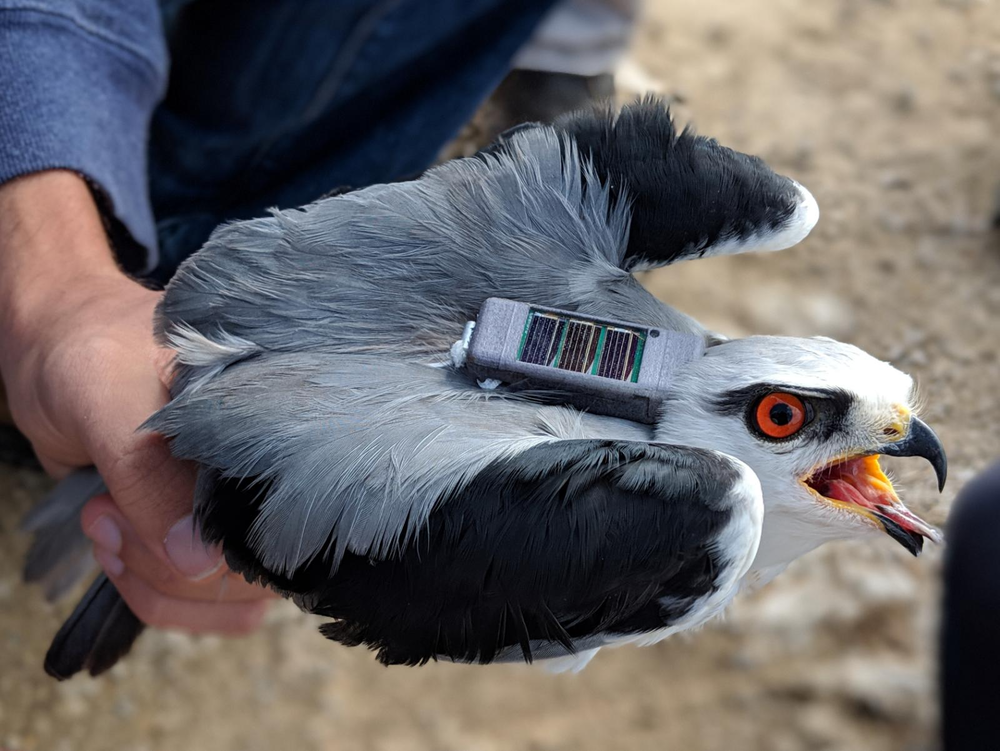Birds of a Feather Hunt Differently

Many types of objects spread out in a random but uniform way, like perfume molecules wafting through the air. A new study of predatory birds, however, has found that their movement is nonuniform, with long pauses of irregular length [1]. This atypical pattern of motion is nonergodic, meaning that the average behavior of a single bird over time is different than the average behavior of many birds at a single time. The results suggest that many predators adopt a hunting strategy that is highly variable in order to surprise their prey. Spotting nonergodicity in ecological data is important, say the researchers behind the study, because it can help scientists avoid making invalid assumptions about an individual animal’s behavior.
Ergodicity is a well-established statistical physics principle that says that the individual behaves like the norm. A molecule in a gas, for example, moves along a random, crooked path, but on average, the net progress it makes over time, moving away from its starting point, is the same as the mean displacement (or diffusion) of a large set of molecules. Because of this equivalence between the time average and the ensemble average, one can accurately predict when a person’s perfume will fill a room, or the time it takes for hot coffee to cool to room temperature.
Ergodicity is often assumed in fields beyond statistical physics, such as economics and biology, but there’s evidence that this assumption is not always valid. Studies of cells, for example, have uncovered nonergodicity in the motion of proteins and other molecules within a cell [2]. Recent work has suggested that animal movements may also be nonergodic, but sufficient data weren’t available. Michael Assaf of the Hebrew University of Jerusalem and his colleagues have now tracked several bird populations, confirming anomalous behavior in the birds’ hunting patterns. “Our study is the first to show ergodicity breaking in ecological movement data and in ecology in general,” Assaf says.
Assaf and his colleagues collected data on barn owls, black-winged kites, and common kestrels, all of which are found in the wild in Israel. These predators have similar hunting tactics that include short, intermittent hops when surveilling a small region and long-distance “cruising” when commuting between distant regions. To better understand this behavior, the team used their recently developed tracking system in which a light-weight tag is placed on the back of each bird. The tags emit radio signals that allow the researchers to pinpoint a given bird’s position roughly once every two seconds. A total of 70 birds—a mix of adults and fledglings—were followed for several months, providing over 70 million position data points.
In their statistical analysis, the team separated the bird movements into two types of behavior: continuous cruising and stop-and-go foraging. They found that the long-range cruising was ergodic, but the short-range foraging was nonergodic because of long stationary periods when the birds waited to ambush their prey. The waiting times were highly variable, with some individuals lying in wait for over an hour and a half. “We did not expect to find such long waiting times during foraging,” Assaf says.
The team believes that the nonergodic hunting methods are an evolutionary adaptation. In the paper describing their work, they give the example of barn owls, whose prey have developed survival strategies, such as staying concealed and moving evasively. But the owls have their own counterstrategy: they vary the time that they wait before attacking. “Adopting irreproducible (and thus unpredictable) movement tactics may prove beneficial for a predator, rather than committing to a single tactic or behavior,” Assaf says.
The researchers expect that other ambush predators, such as cats, snakes, and crocodiles, may adopt nonergodic hunting strategies. Often, ecological studies assume that animal movements are ergodic, which can lead to false conclusions. Assaf gives the example of trying to predict an individual bird’s flight path using a mean velocity taken from a large set of flight data. “Nonergodicity entails that this is incorrect, as the mean velocity is not a good indicator of what the animal will do in any single search,” he says.
“I find this paper very innovative,” says complex dynamics expert Eli Barkai from Bar-Ilan University in Israel. “It is also nice to see how tools developed in physics are used in the context of movement ecology.” He thinks ergodicity is too often regarded as absolute truth, so it is important to highlight when it breaks down.
Ecologist Simon Benhamou from the Center of Functional and Evolutionary Ecology in France agrees that traditional statistics do not always capture the idiosyncrasies of animals. “As individual animals are not interchangeable,” he says, “we can expect that statistical physical laws involving a huge number of identical particles cannot apply directly.”
–Michael Schirber
Michael Schirber is a Corresponding Editor for Physics Magazine based in Lyon, France.
References
- O. Vilk et al., “Ergodicity breaking in area-restricted search of avian predators,” Phys. Rev. X 12, 031005 (2022).
- R. Metzler et al., “Anomalous diffusion models and their properties: Non-stationarity, non-ergodicity, and ageing at the centenary of single particle tracking,” Phys. Chem. Chem. Phys. 16 (2014).




